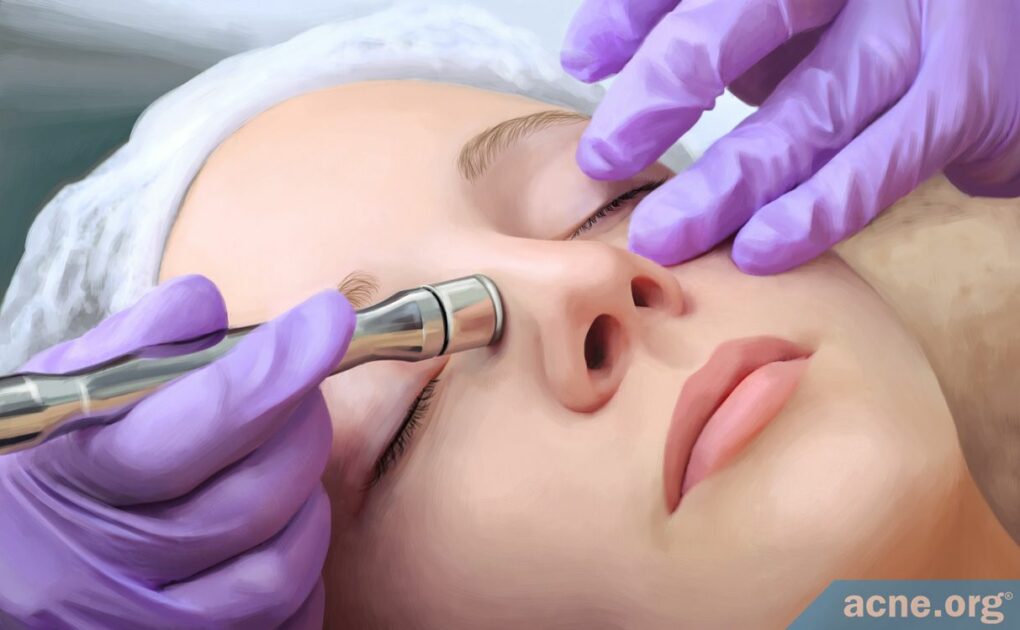There Is No Scientific Evidence That Microdermabrasion Improves Acne, and the Irritation It Causes May Actually Worsen Acne

The Essential Info
What It Is: Microdermabrasion is a painless cosmetic procedure that involves using a device that shoots tiny aluminum oxide particles at the skin, thus dislodging and removing surface skin cells.
Cost: It normally requires 6 – 10 treatments and the price can vary widely, from $375 all the way up to $3200 when all is said and done.
Acne: Although some marketers assert that microdermabrasion can improve or prevent acne, there is no scientific evidence to support this claim. In fact, when you undergo microdermabrasion, it will cause physical irritation of the skin. Generally speaking, anything that physically irritates the skin can make acne worse. Therefore, microdermabrasion is not recommended for people who are currently experiencing breakouts.
Acne Scarring: Because microdermabrasion only removes surface skin cells, it is unlikely to provide any benefit for acne scarring.
My Take: I would advise anyone with acne-prone skin to avoid microdermabrasion. It is physically irritating to the skin, which means it may lead to more acne. However, if you never break out, have some extra money, and want to undergo a fun procedure that will give you a temporary “glow,” go for it.
Caution – Don’t Undergo Microdermabrasion while on Isotretinoin: Isotretinoin, an oral acne medication, makes the skin much more vulnerable and delicate, so is recommended to wait at least one (1) year after stopping isotretinoin before undergoing microdermabrasion.

The Science
- How It Works
- Can It Make Acne Worse?
- Benefits: Smoother, Brighter Skin
- What Does It Feel Like?
- How Many Sessions Are Required, and How Often?
- How Much Does It Cost?
Microdermabrasion is a cosmetic beauty procedure that aims to rejuvenate the skin by using a device that sprays the skin with tiny aluminum oxide crystals, which removes dead skin cells from the skin surface.
If you suffer from acne, you may wonder whether microdermabrasion could improve your acne, as some marketers claim. On the other hand, you may be concerned that the procedure could actually make your acne worse by irritating the skin. In reality, there is no evidence that microdermabrasion has any effect at all on acne, either positive or negative.
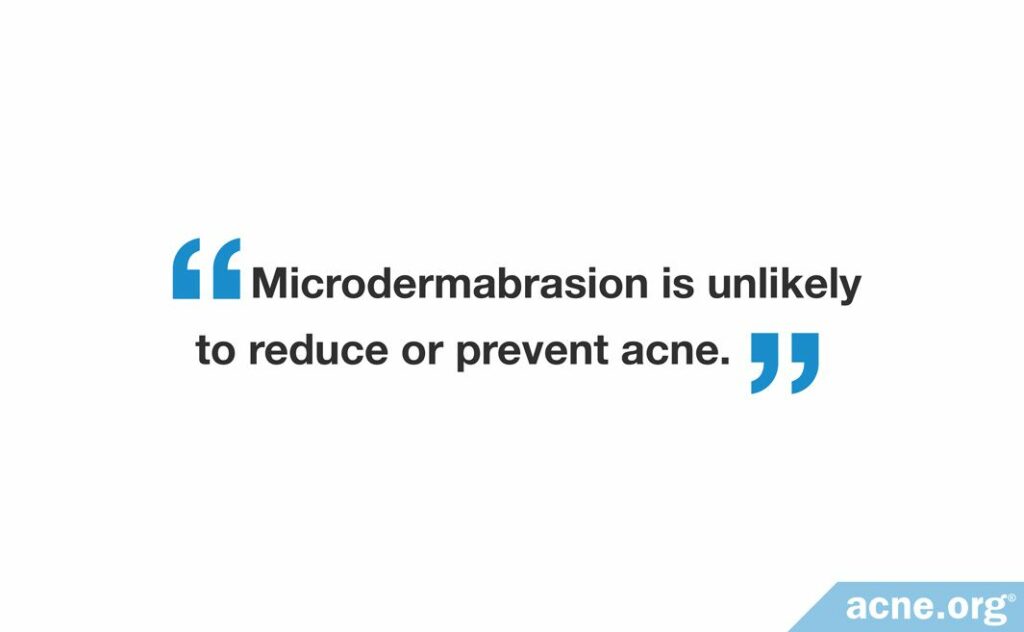
While microdermabrasion is unlikely to reduce or prevent acne, as a beauty treatment, it does lead to minor improvements in the appearance of the skin, helping the skin to look smoother, softer, and brighter after the procedure. To see these benefits, most people need between 5 and 16 treatments (6 – 10 is typical), each of which is painless and lasts about 30 – 60 minutes.
How Microdermabrasion Works
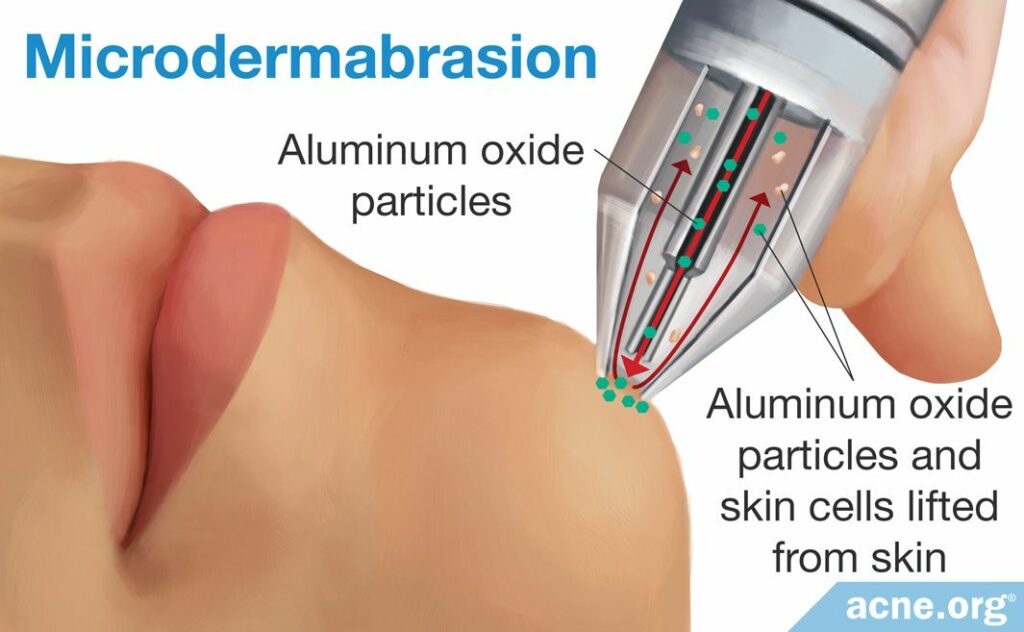
A microdermabrasion machine sprays the skin with tiny crystals of aluminum oxide. When these crystals bombard the skin, they gently buff the skin, removing dead skin cells from the top layer of the skin. As the dead skin cells slough off the skin surface, the microdermabrasion machine lightly vacuums them up, together with the crystals.4
The skin is divided into three layers, and the outermost layer is called the epidermis. Microdermabrasion only reaches the very top layer of the epidermis, which is called the stratum corneum.4 In other words, microdermabrasion only removes a few layers of cells all the way at the surface of the skin.
Zooming in on the stratum corneum
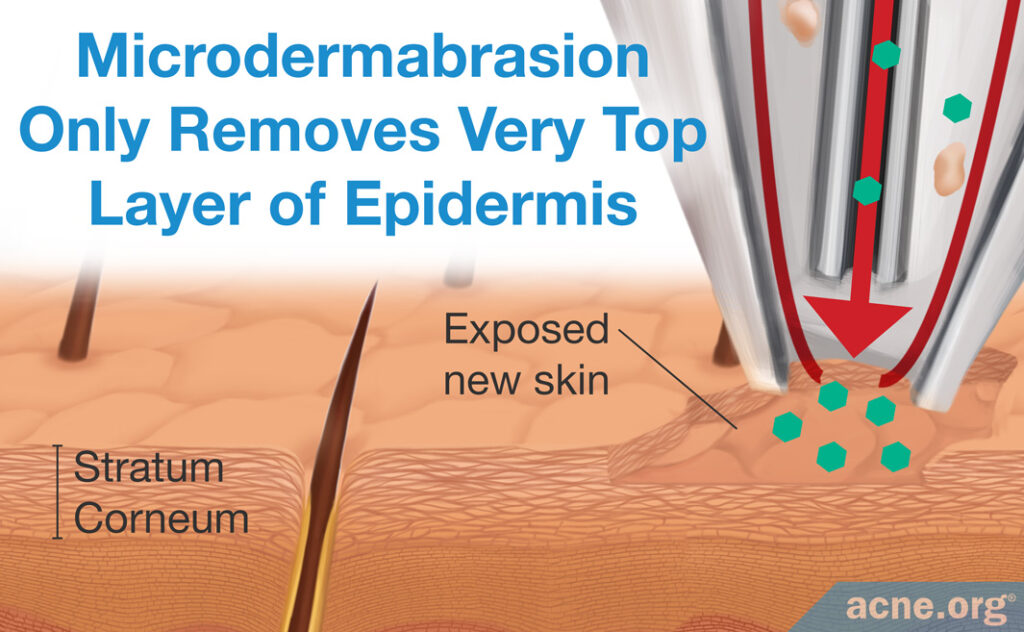
The stratum corneum consists of approximately 15 – 20 layers of dead skin cells and is approximately 30 – 40 microns thick–a little less than the thickness of a human hair. Microdermabrasion removes the top 10 – 15 microns: in other words, it removes about 1/3 of the stratum corneum.4 Simply put, microdermabrasion skims off the top of the stratum corneum, which is itself only the most superficial part of the epidermis. This means that microdermabrasion cannot unclog pores, which originate in deeper layers of the skin.
When any exfoliant removes surface dead cells, this can signal deeper layers of the skin to produce more skin cells to replace those lost at the surface. If microdermabrasion were to help reduce acne, this is one way it might do so. By signaling the production of new skin cells, old skin cells have less of a chance to “hang around” and become stuck together, creating a clog.5 However, will the physical irritation that microdermabrasion causes negate the potential benefits of exfoliation when it comes to acne?
The Research: Microdermabrasion Has Not Been Shown to Improve Acne
To date, only one small and deeply flawed research study has been performed on microdermabrasion and acne. It purports to show that microdermabrasion improves acne. The study was published in 2001 in the journal Dermatologic Surgery,6 but its conclusions are unreliable.

In the study, 24 participants with acne received 8 microdermabrasion treatments over the course of 2 months. The researcher used photographs to compare the severity of the participants’ acne before and after the treatments. At the end of the experiment, 38% of the participants showed excellent results; 34% showed good results; 17% showed fair results, and only 12% exhibited poor results. The researcher concluded that microdermabrasion is a promising procedure for the treatment of acne.6
Flaws in this study:
There were several major flaws in the design of this study. The main problem is that the participants were also using acne medications throughout the study. This means that we cannot be sure that it was microdermabrasion and not the medications that improved the participants’ acne. To avoid this problem, the researcher did not include a control group. A control group is a second group of participants who do not get the treatment that the researcher is trying to test. In this case, the control group would have to consist of participants who had acne and were taking acne medications but who did not receive microdermabrasion. Then, the researcher could have compared the two groups to see whether microdermabrasion really caused any improvement in acne.
Next, rather than counting the number of lesions, the researcher also used an imprecise method of gauging results, simply describing the results as “excellent,” “good,” “fair,” or “poor.” This vague description does not provide any specific information about how much the participants’ acne improved. However, the main issue remains that any improvement may have been caused by the medications and not the microdermabrasion treatments.
Because of the problems with this study, another doctor, Dr. Gary Palmer, wrote a letter to the editors of Dermatologic Surgery, which was published in the journal later the same year.7 In his letter, Dr. Palmer listed the flaws in the study and concluded, “I was amazed this article was approved…As far as I am concerned, this study proves nothing…[It] is completely meaningless.”7 In other words, we cannot consider this study as evidence that microdermabrasion improves acne.
The Research: Microdermabrasion Might Contribute to Reducing Skin Oil
Some recent research suggests that one way microdermabrasion might potentially help with acne is by reducing the amount of skin oil the skin produces. Less skin oil generally means less acne.
To date, 2 studies have tested whether microdermabrasion might reduce the production of skin oil. However, both studies were deeply flawed, as we will see below.
Study #1

The first study was published in the Journal of Cosmetic and Laser Therapy in 2019 and included 9 women with acne. The participants received 6 treatments with microdermabrasion and cavitation peeling, which is another painless procedure that uses ultrasound waves to exfoliate the skin. The treatments were spaced 10–14 days apart. The researchers took measurements of the amount of skin oil on the participants’ faces before and after the series of treatments. They found that the combination of microdermabrasion and cavitation peeling significantly reduced skin oil, which might theoretically help with acne.8
Flaws in this study:
Much like the study on microdermabrasion and acne discussed above, this study had serious flaws:
- The study only included 9 participants, which is too few to draw any far-reaching conclusions.
- The researchers did not follow up with the participants to see if the reduction in skin oil was long-lasting, or if the amount of skin oil quickly went back to its original levels after the treatments were over.
- There was no control group who received only cavitation peeling without microdermabrasion for comparison. Therefore, we cannot determine whether adding microdermabrasion played any role in reducing the amount of skin oil on the participants’ skin, or if the effect was purely due to the cavitation peeling.
Study #2

The second study was published in the Journal of Clinical Medicine in 2022. This study tested whether microdermabrasion together with a chemical peel might work better than a chemical peel alone for reducing skin oil and improving acne. A total of 14 women with acne participated in this study. The women received microdermabrasion and a chemical peel containing 40% pyruvic acid on the right side of the face, and only the chemical peel without microdermabrasion on the left side of the face. Each treatment was performed 4 times, spaced 2 weeks apart. The researchers compared the amount of skin oil on both sides of the women’s faces before and after the course of treatment, as well as 1 month later. They found that the side of the face that received microdermabrasion had less skin oil after the treatment, and this difference was still there 1 month later.9
Flaws in this study:
This study was more reliable than the first study because it did include a control group. In this case, the left side of the women’s faces was the control group, because the left side received the chemical peels, but not the microdermabrasion treatments. By comparing the 2 sides of the women’s faces, the researchers could see that the microdermabrasion did seem to make a difference.
However, there were still important flaws in this study:
- It only included 14 participants.
- It never looked at microdermabrasion by itself, but only in combination with a chemical peel. Therefore, it is possible that microdermabrasion might improve the results of other treatments but might not have any effect on skin oil production by itself.
Taken together, these 2 studies highlight a direction for further research but do not give us enough evidence to expect that microdermabrasion by itself would help with acne to any measurable degree.
Microdermabrasion cannot reduce acne scars
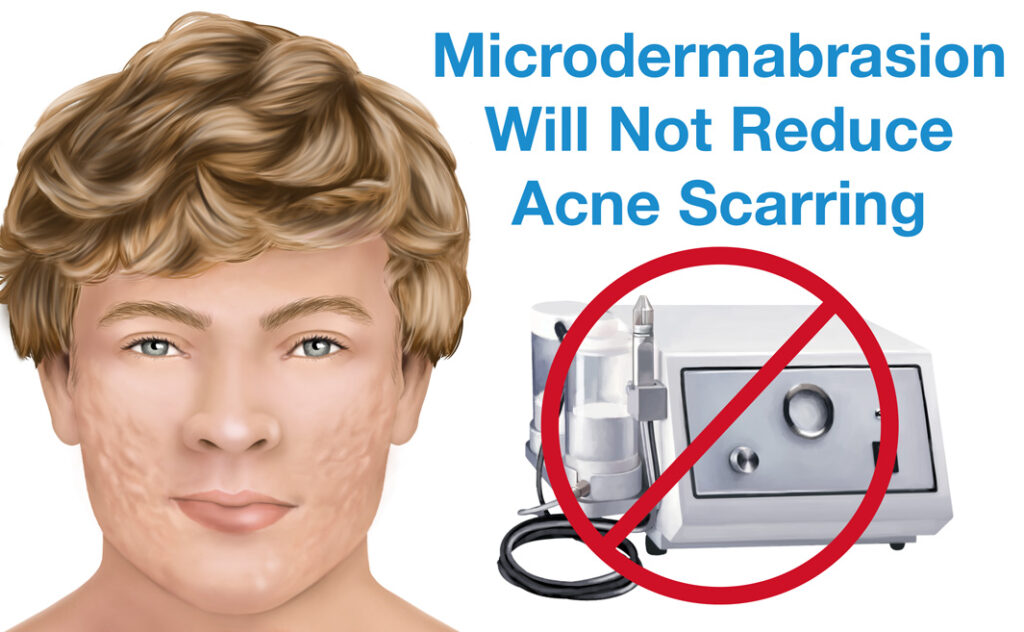
Some marketers claim that microdermabrasion can help to reduce scars caused by acne. This is highly unlikely, since microdermabrasion only affects the very surface-most skin cells, while acne scars go much deeper and involve the rest of the epidermis and dermis. While microdermabrasion may help the skin temporarily produce more collagen and elastin, it is extremely unlikely that this will produce any noticeable or lasting effect on acne scars, and the research conducted so far backs this up.1-3 Instead, there are other effective acne scar treatments that can help.
Can Microdermabrasion Make Acne Worse?
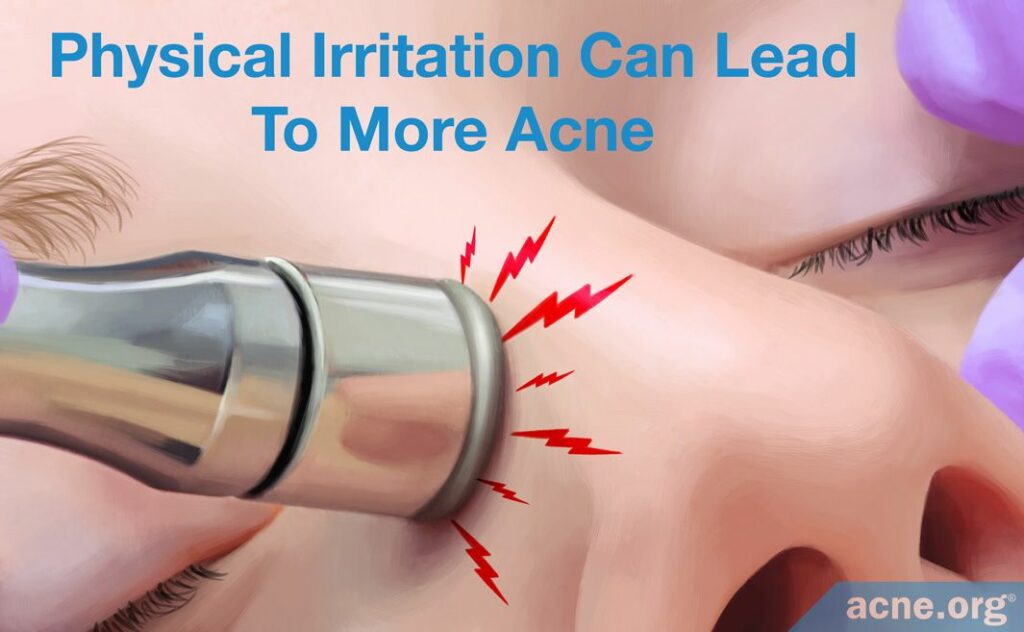
It is possible that rather than improving acne, microdermabrasion could actually make acne worse by causing physical irritation to the skin.
Many things that physically irritate the skin can trigger acne. Some examples of physical irritants include:
- Constantly supporting your chin with your hands, which can cause acne on the chin
- Wearing turtleneck sweaters and shirts with tight collars, which can cause acne on the neck
- Wearing a face mask while playing a sport, which can cause acne around the mouth and chin10
Therefore, it is possible that microdermabrasion, which involves rubbing of the skin with the microdermabrasion device, could also trigger acne in acne-prone skin. Until research is conducted to study the effects of microdermabrasion on acne-prone skin, we will not know whether the procedure can trigger a breakout.
Doctors do not recommend the procedure to people who already have active acne.11 In other words, microdermabrasion should be looked at as a beauty treatment for people who are not prone to acne, and not an acne treatment itself.
Avoid Microdermabrasion If You Have Taken Isotretinoin (Accutane) in the Past Year
Additionally, the American Academy of Dermatology recommends that people who have taken isotretinoin (Accutane®) to treat their acne in the past six months avoid microdermabrasion, because isotretinoin radically alters the skin, and the procedure could cause complications like scarring.12 Some doctors even suggest avoiding microdermabrasion for a year after taking isotretinoin.11 Therefore, to be on the safe side, if you have used isotretinoin to treat your acne, it may be a good idea to wait a full year before considering microdermabrasion.
The Real Benefits of Microdermabrasion: Smoother, Brighter Skin
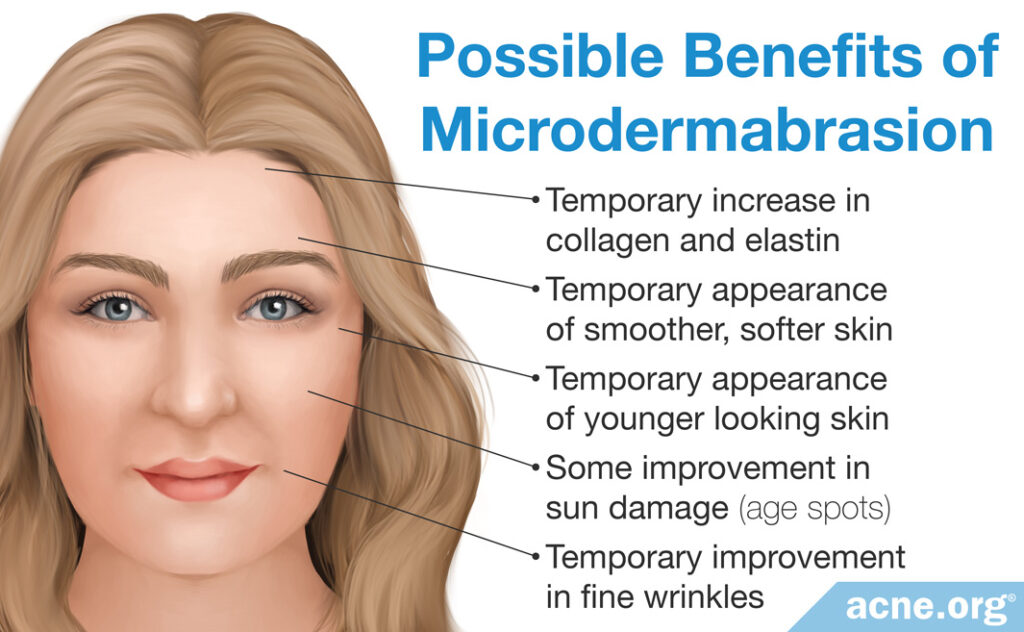
Since there is no evidence that microdermabrasion improves acne, and it is even possible that the procedure can make acne worse, you may wonder why anyone would consider undergoing this procedure. But if we look at microdermabrasion simply as a cosmetic procedure unrelated to acne, there are some benefits.

One study, also published in 2001 in the journal Dermatologic Surgery, looked at participants’ skin after three treatments with microdermabrasion. The researchers compared the skin of these participants to the skin of people who did not receive any treatment, and found that the skin of people who underwent microdermabrasion contained more proteins called collagen and elastin. These proteins make the skin smoother and softer.13 As a result, many people who undergo microdermabrasion feel that their skin begins to look younger after a series of treatments.12
In addition, research has shown that microdermabrasion can improve sun-damaged skin, fine wrinkles, and age spots.13 Because microdermabrasion removes dead skin cells from the skin surface, people often report that their skin starts to look more radiant after treatment.12
What Does It Feel like to Undergo Microdermabrasion?
Microdermabrasion is painless and does not require anesthesia. People describe it very much like what it is…very fine crystals, like a very fine sand, being moved across the skin, and vacuumed back up. You can feel it, but it is not painful. The procedure usually takes 30 – 60 minutes.
What Is Your Skin like after Microdermabrasion?
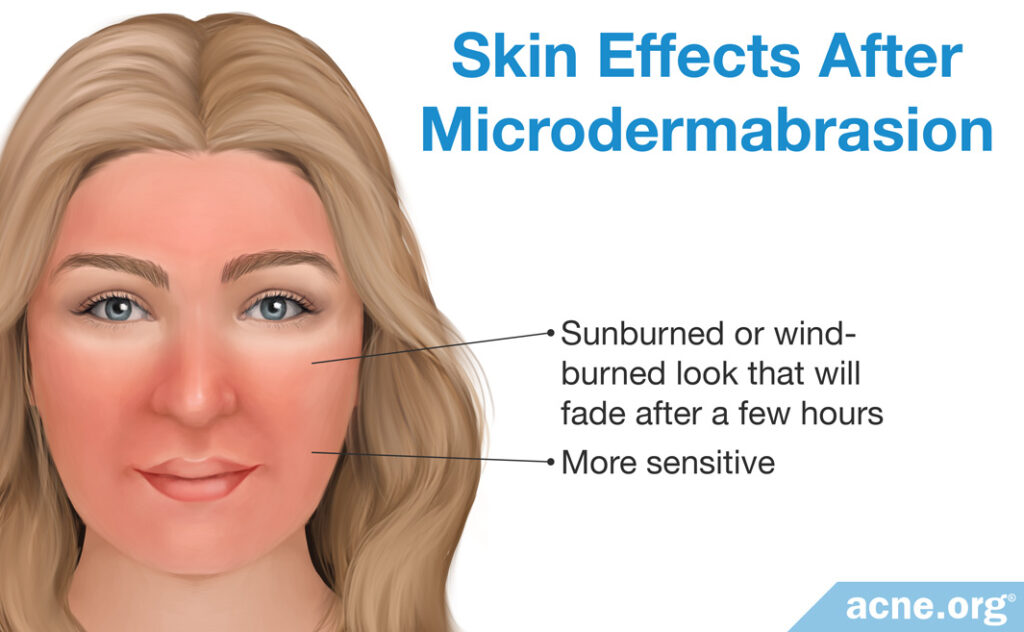
Your skin will be pink after the procedure, and this pink hue will fade after a few hours. People often describe it as a sunburned or wind-burned look. Your skin will most likely feel more sensitive after treatment, so exercise caution when applying topical treatments in the hours following microdermabrasion.
How Many Sessions Are Required, and How Often?
To achieve the smooth and more youthful look that microdermabrasion promises, 5 – 16 procedures are required (6 – 10 is typical), spaced one to four weeks apart.12
How Much Does Microdermabrasion Cost?
In the U.S., it usually costs from $75 – $200+ per session, which is a wide range. When you factor in a that you can get anywhere from 5 – 16 sessions, a full course could potentially cost $375 all the way up to $3200. For the typical 6 – 10 treatments, the range would be $450 – $2000. The cost of a session depends on what type of professional performs the procedure, how long each session takes, and regional price differences around the country.
Who Can Perform Microdermabrasion?
Many professionals, including estheticians, can perform microdermabrasion. In fact, there are even microdermabrasion kits that you can use at home. However, doctors recommend that you consult a dermatologist before undergoing microdermabrasion if you have:
- A mole or other spot on your skin that is growing, bleeding, or changing in any way
- A tendency to scar easily
- A bacterial or viral infection affecting the skin
- Used isotretinoin (Accutane) within the past year
- Had facial surgery in the past two months
- Undergone radiation therapy to the head11,12
The History of Microdermabrasion
The idea of removing the top layers of the skin dates as far back as 1500 BCE, when the ancient Egyptians used sandpaper to improve scars. Obviously, this technique was much rougher than microdermabrasion, and it affected layers of the skin much deeper than microdermabrasion affects.
The early 20th century saw the development of a new procedure called dermabrasion, not to be confused with microdermabrasion. Unlike microdermabrasion, dermabrasion is a surgical procedure that requires an anesthetic. In dermabrasion, a dermatologist or plastic surgeon removes the entire epidermis and the upper portion of the dermis using a device like a wire brush, a diamond wheel, sterilized sandpaper, or another mechanical tool. While dermabrasion can reduce the appearance of scars, it can also cause various complications, and because the procedure is so invasive, the skin takes six to nine months to completely heal afterwards.14
In 1985, two Italian doctors, Dr. Marini and Dr. Lo Brutto, developed microdermabrasion as a less aggressive, painless alternative to dermabrasion. Unlike dermabrasion, microdermabrasion does not require anesthesia. Another doctor, Dr. Monteleone, presented the new technique to the medical community at the Third Meeting of the Southern Italy Plastic Surgery Association in 1988. After this, microdermabrasion spread throughout Europe during the late 1980s and mid-1990s, until eventually Mattioli Engineering introduced the procedure to the U.S. market in 1996.14
References
- Kravvas, G. & Al-Niaimi, F. A systematic review of treatments for acne scarring. Part 1: Non-energy-based techniques. Scars Burn Heal 3, 2059513117695312 (2017). https://pubmed.ncbi.nlm.nih.gov/29799567/
- Aronsson, A., Eriksson, T., Jacobsson, S. & Salemark, L. Effects of dermabrasion on acne scarring. A review and a study of 25 cases. Acta Derm Venereol 77, 39-42 (1997). https://pubmed.ncbi.nlm.nih.gov/9059675/
- El-Domyati, M., Hosam, W., Abdel-Azim, E., Abdel-Wahab, H. & Mohamed, E. Microdermabrasion: a clinical, histometric, and histopathologic study. J Cosmet Dermatol 15, 503-513 (2016). https://pubmed.ncbi.nlm.nih.gov/27357600/
- Microdermabrasion: Background, History of the Procedure, Problem. (2017). https://emedicine.medscape.com/article/843957-overview
- Kempiak, S. J. & Uebelhoer, N. Superficial chemical peels and microdermabrasion for acne vulgaris. Semin Cutan Med Surg 27, 212 – 220 (2008). https://www.ncbi.nlm.nih.gov/pubmed/18786500
- Lloyd, J. R. The use of microdermabrasion for acne: a pilot study. Dermatol Surg Off Publ Am Soc Dermatol Surg Al 27, 329 – 331 (2001). https://www.ncbi.nlm.nih.gov/pubmed/11298700
- Palmer, G. D. Regarding the study on microdermabrasion for acne. Dermatol Surg Off Publ Am Soc Dermatol Surg Al 27, 914 (2001). https://www.ncbi.nlm.nih.gov/pubmed/11442587
- Kołodziejczak, A., Wieczorek, A. & Rotsztejn, H. The assessment of the effects of the combination of microdermabrasion and cavitation peeling in the therapy of seborrhoeic skin with visible symptoms of acne punctata. J Cosmet Laser Ther 21, 286-290 (2019). https://pubmed.ncbi.nlm.nih.gov/30300026/
- Rusztowicz, M., Chilicka, K., Szyguła, R., Odrzywołek, W., Yanakieva, A., Asanova, B. & Wilczyński, S. A split face comparative study to evaluate the efficacy of 40% pyruvic acid vs. microdermabrasion with 40% pyruvic acid on biomechanical skin parameters in the treatment of acne vulgaris. J Clin Med 11, 6079 (2022). https://pubmed.ncbi.nlm.nih.gov/36294402/
- Dreno, B., Bettoli, V., Perez, M., Bouloc, A. & Ochsendorf, F. Cutaneous lesions caused by mechanical injury. Eur J Dermatol 25, 114 – 121 (2015). https://link.springer.com/article/10.1684/ejd.2014.2502
- AlKhawam, L. & Alam, M. Dermabrasion and Microdermabrasion. Facial Plast Surg 25, 301 – 310 (2009). https://www.ncbi.nlm.nih.gov/pubmed/20024871
- American Academy of Dermatology. Microdermabrasion. Retrieved from https://www.aad.org/cosmetic/age-spots-marks/microdermabrasion-overview#faqs
- Freedman, B., Rueda-Pedraza, E. & Waddell, S. The epidermal and dermal changes associated with microdermabrasion. Dermatol Surg 27, 1031 – 1034 (2001). https://www.researchgate.net/publication/227641401_The_Epidermal_and_Dermal_Changes_Associated_with_Microdermabrasion
- Shpall, R., Beddingfield, F. C., Watson, D. & Lask, G. P. Microdermabrasion: a review. Facial Plast Surg FPS 20, 47 – 50 (2004). https://europepmc.org/abstract/med/15034813
 Acne.org Products
Acne.org Products